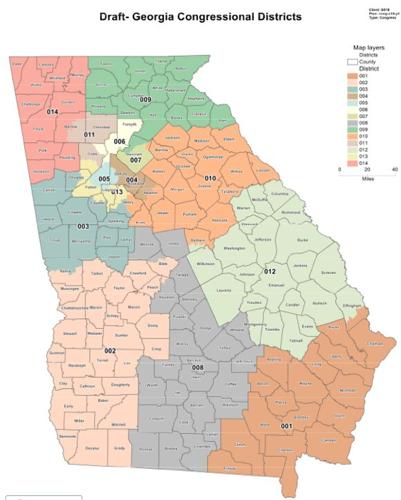ATLANTA — Georgia’s new voting district map for the next 10 years is on its way to Gov. Brian Kemp's desk, following the General Assembly’s approval Monday of the Republican-led redistricting plan.
Since the last redistricting cycle in 2010, the state’s population grew 10% — by 1 million people — and all of it in minority populations.
Currently, eight of 14 of Georgia’s U.S. Representative seats are held by Republicans. The state’s two U.S. Senate seats were won by Democrats in 2020 and the majority of the state voted for Democrat President Joe Biden. The new map is expected to give Republicans a 9-5 advantage.
“Unfortunately, the majority's proposal provides it with a significant Republican advantage that fails to reflect the preferences of Georgia voters in a state that is equally divided politically, a map that provides either party a significant partisan advantage,” said Sen. Gloria Butler, Democratic Minority Leader during the Senate committee meeting. “Their map discriminates against and reduces the voting power of Georgians with different political viewpoints.”
The Republican-led map expands northwest Georgia’s Congressional District 14 — currently held by Republican Marjorie Taylor Greene — down to Cobb County in northwest metro Atlanta; in addition the map extends metro Atlanta’s Congressional District 6 — currently held by Lucy McBath — up toward Republican-leaning areas in north Georgia.
The map stretches two of Georgia’s Democratic congressional districts in rural Republican districts, an effort opposers said is to diminish Democrat advantage.
Bonnie Rich, R— Suwannee, disputed those claims Monday, prior to the House’s vote.
“The law requires that we draw maps that equally apportion the population among the districts. And that we give minority communities an opportunity to elect a candidate of their choice,” said Rich, chair of the House Legislative and Congressional Reapportionment committee. “It does not mean that a majority white district like the 6th that elects a minority candidate, all of the sudden gets a lifelong protection under the Voting Rights Act for that incumbent. It doesn't work like that. We don't draw maps to protect incumbents, an individual who happens to be sitting in the seat. We draw maps for the people, for the voters, for the districts.”
Cobb is among several metro Atlanta areas that have grown in diversity and have voted Democrat in recent elections.
State Rep. Erica Thomas, D-Mableton, whose seat lies within District 14 said her constituents — largely minorities — are against the shift, citing differences in values of north Georgians.
“Even if 100% of them come out to vote, they will never get the representation that they vote for. They have been paired with a district that does not look like them, or share the values of them,” Thomas said at the Georgia House’s Legislative and Congressional Reapportionment hearing. “Why split and dilute the voting power of people of color in West Cobb and put them in a district that is so clearly where they don't belong? They would like a representative that looks like them or even a representative that represents the values that my district has.”
Austell resident Leroy Hutchins added, “We are in Cobb County but we very much look like Metro Atlanta and the ideals that we have are representative that some of the things that we focused on — with Six Flags being right there in our back door — is tourism and transportation. But the (proposed) map the way it looks, would be more focused on agriculture and more rural opinions versus what we're looking at here in the southern portion of the county.”
Ken Lawler of Fair Districts GA said metro Atlanta's Congressional District 6 was also unnecessarily paired into a rural district.
“In the sixth district, which was only about 650 people overpopulated, over 45% of the voters in that district were moved out,” he said. “Now you can't fix it by just moving 650 people you're going to have to move more but I have a hard time buying the idea that you're maintaining the core of that district when almost half of it is being moved out, when only a tiny, tiny percentage needed to be moved to equalize the population."
He said the same kind of unnecessary shifting is part of the new Congressional District 7 — also held by a Democrat, Carolyn Bourdeaux. The district is currently over populated by more than 10% — or 94,000 people — but 49% of its voters were moved into a different district.
“Unfortunately, the majority's proposal provides it with a significant Republican advantage that fails to reflect the preferences of Georgia voters in a state that is equally divided politically, a map that provides either party a significant partisan advantage,” said Sen. Gloria Butler, Democratic Minority Leader during the Senate committee meeting. “Their map discriminates against and reduces the voting power of Georgians with different political viewpoints.”
Despite opposition to the new districts, Republicans have defended the map, saying that it meets redistricting requirements and complies with the Voting Rights Act.
State Sen. John Kennedy, R-Macon, asserts that some splitting of areas and precincts is inevitable in order to meet population requirements.
Much of Georgia’s population growth occurred in metro areas of Atlanta, causing south districts to shift more northward, he said.
“You'll note that the same phenomenon, if you will, that we had with regard to the (state) Senate district maps and having to make up population deficits in the southern part of the state that had an accordion effect of pushing the districts northward," said Kennedy, chair of the Senate Reapportionment and Redistricting Committee. "You'll see the same effect going in the congressional maps. You'll also see the same across the northern tier, coming south for population drivers as well.
“We've got our traditional districts in the corners of the state and the cores of existing districts that are largely maintained in the map that you have," Kennedy continued. "While incumbents don't have to live in their districts for Congress, every incumbent member of the Congress has a district to run in.”
The Princeton Gerrymandering Project graded the map a “C” rating overall for partisan fairness, competitiveness and geographic features.
The map was approved in the Senate 32-21 on Nov. 19 and Nov. 22 in the House, 96-68, both generally along party lines.
Critics of the maps decried rushed approvals, not allowing time enough time for the public to review, during the process.
“This was not a deliberative process that valued the people of Georgia," said Fair Count CEO Rebecca DeHart. "It was farcical, light-speed-rushed theatre, and it was politics at its ugliest. Throughout Georgia's redistricting process, the only consistency the public has been able to count on has been disingenuousness, including shortened public comment periods, maps not revealed until just before they were voted on, and unreviewed last-minute changes to the district lines that will affect us for the next 10 years."



























Commented
Sorry, there are no recent results for popular commented articles.